If you’ve ever travelled the east coast of Australia, you’re guaranteed to have seen a range of banksias growing. However, banksias are also a great option when it comes to garden plants.
This fuss-free flora has spectacular foliage and eye-catching blooms, which will attract a range of wildlife to your garden, with such a wide variety of species to choose from, from larger trees to medium-sized shrubs and even ground covering varieties.
Perfectly accustomed to our landscapes, banksias are a great option for beginner growers who want a striking garden plant – without too much maintenance.
Here is some more insight on the Banksia species and varieties, as well as helpful tips on how to grow and care for them.
More...
What are Banksias?
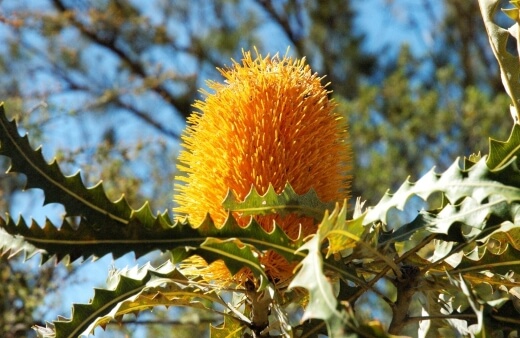
Banksias are a native Australian flowering plant with a continuous bloom cycle. These drought-tolerant, attractive and incredibly versatile are often used in landscaping as a feature garden plant, filler plant or ground cover.
The most striking feature of the banksia plants is its bottle-brush-like blooms which come in a variety of colours, including cream, yellow, brown, orange and green.
These blooms are brilliant pollen producers and will attract a range of birds, bees and butterflies throughout the year. Part of the Proteaceae family, the Banksia genus encompasses over 70 different species.
While there are too many to mention each in detail, we will take a look at some of the most popular species available.
Popular Banksia Varieties
There is an endless variety of beautifully blooming banksias to choose from. Each has unique flowering and growth habits, and it will be up to you to decide which will suit your garden best.
Here are some of the most popular and successful varieties to grow:
Coastal Banksia (Banksia integrifolia)
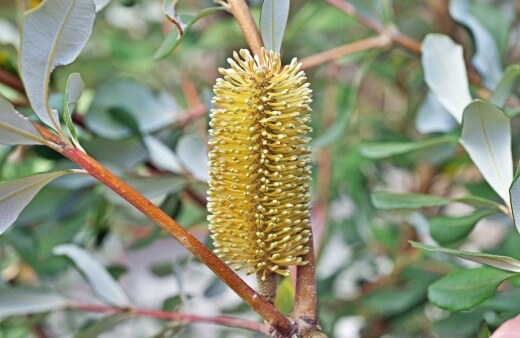
Also known as the coastal banksia, this variety is most commonly found along the east coast of Australia. This hardy, shrub-like species is incredibly resistant to salty winds, frost and drought.
Firewood Banksia (Banksia menziesii)
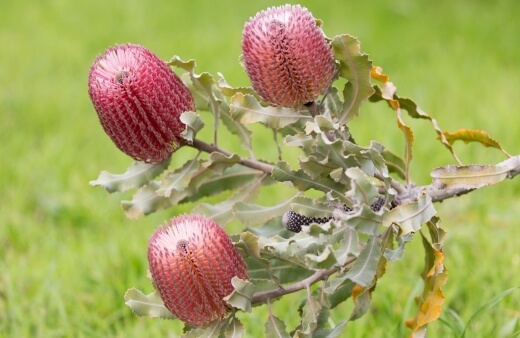
If something more striking is what you’re after, consider the B. menziesii or firewood banksia. This is an incredibly ornamental species with serrated, dull-green leaves and this red and yellow blooms.
Banksia menziesii Growing and Care Guide


Get Your Free Guide:
Master Growing Australian Natives eBook
A Must Have Complete Guide for Every Australian Garden
Get Your Free Guide:
Master Growing Australian Natives eBook
A Must Have Complete Guide for Every Australian Garden
Silver Banksia (Banksia marginata)

Also known as the silver banksia, this species is most commonly found across south-eastern Australia. The silver banksia has long green leaves with striking silver undersides.
Old Man Banksia (Banksia serrata)
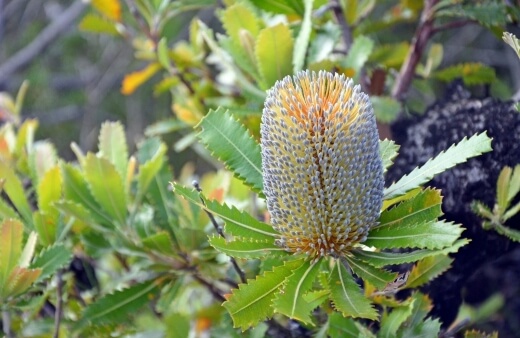
If you’re considering something taller-growing, you may want to look at the B. serrata or old man banksia. This species has wonderfully thick blooms, said to resemble a protea, which ranges in colour from white to yellow.
Hairpin Banksia (Banksia spinulosa)
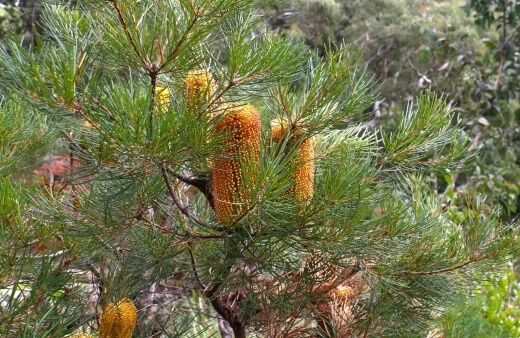
Another heavy bloomer is the B. spinulosa or hairpin banksia, and it’s the perfect option for first-time banksia growers. With blooms in every shade of the sunset and a hassle-free care routine, you won’t regret growing this species.
Scarlet Banksia (Banksia coccinea)

Also known as the scarlet banksia or waratah banksia, the B. coccinea offers one of the most curious blooms. Its dramatic flowers are slightly wider than most other varieties and contrast beautifully against the larger green leaves.
Orange Banksia (Banksia prionotes)
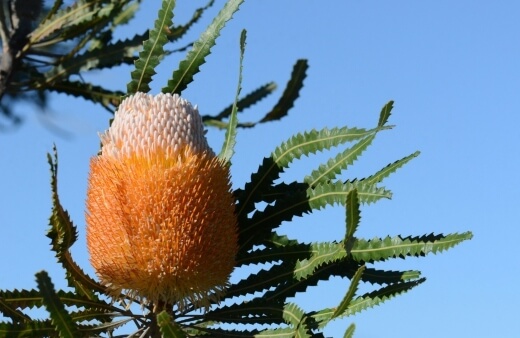
The B. prionotes or orange banksia is another species with heavier set blooms. This species can be grown as a tree or as a shrub, and when it blooms offers an incredible spectacle for the eye to see.
In its habitat in Western Australia, the B. prionotes reach as much as 10 metres high.
Showy Banksia (Banksia speciosa)
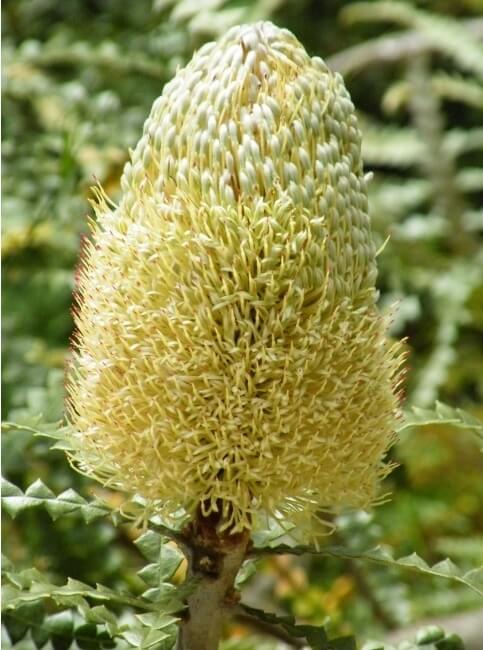
The B. speciosa or showy banksia is one species that absolutely lives up to its name. Found on the south coast of Western Australia, this stunning species is best recognised by its prominent flowers and geometric leaf design.
Candlestick Banksia (Banksia attenuata)
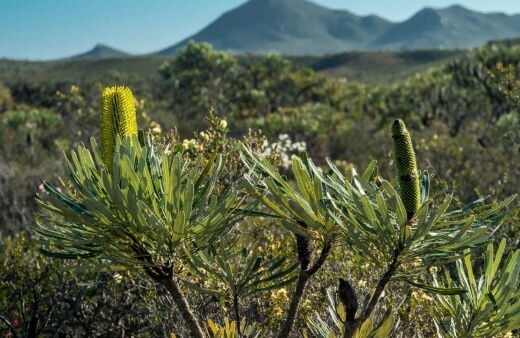
More commonly known as the candlestick banksia, this species has unlikely, oblong growing blooms, which come in a range of white to bright yellow.
Although often grown as a shrub reaching only 2 metres tall, the candlestick banksia can grow as much as 10 metres tall.
Bull Banksia (Banksia grandis)
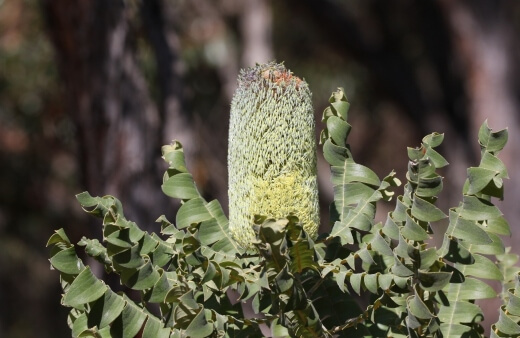
As grand as the name suggests, the B. grandis or bull banksia is a common species with large, yellow flower heads and huge, toothed foliage.
The bull banksia is particularly suited to very sandy soils and offers a lot of bang for your buck.
Ground Cover Banksia (Banksia blechnifolia)
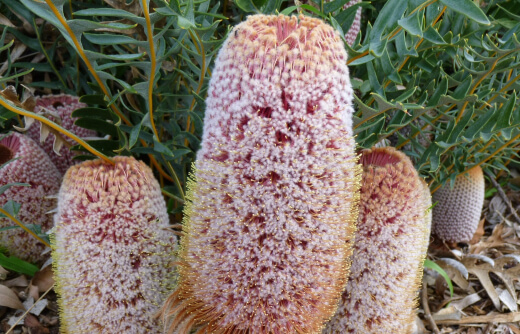
Source: Gardeningwithangus.com.au
Looking like something straight out of Alice in Wonderland, the B. blechnifolia is most praised for its intricate blooms and wide-spreading foliage.
Often used as a ground cover, this species only grows about half a metre tall but can spread as much as 4 metres wide.
Woolly Banksia (Banksia baueri)
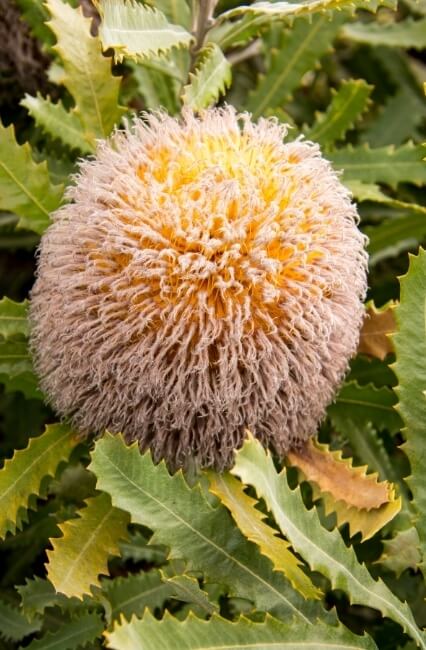
Ideally suited to more humid climates, the B. baueri is another fantastically blooming species, best grown as a lower-growing shrub.
Ashby's banksia (Banksia ashbyi)

As exotic as it sounds, the B. ashbyi is another smaller growing shrub or tree with fantastically alluring yellow blooms.
Banksia ashbyi Australian Growing + Care Guide
Heath Banksia (Banksia ericifolia)

Also known as the lantern banksia, this variety is famed for its large flame-like orangey-red autumn flowers and fine-leaved green foliage. It occurs largely in NSW and across the east coast, being a great pick for coastal gardens and landscapes.
This medium-sized shrub is very hardy and makes for an excellent ornamental feature or used for hedging and screening.
Coastal Banksia |  |
|---|---|
Firewood Banksia |  |
Silver Banksia |  |
Old Man Banksia |  |
Hairpin Banksia |  |
Scarlet Banksia |  |
Orange Banksia |  |
Showy Banksia |  |
Candlestick Banksia |  |
Bull Banksia (Banksia grandis)As grand as the name suggests, the B. grandis or bull banksia is a common species with large, yellow flower heads and huge, toothed foliage. The bull banksia is particularly suited to very sandy soils and offers a lot of bang for your buck. |  |
Ground Cover Banksia |  Source: Gardeningwithangus.com.au |
Woolly Banksia (Banksia baueri)Ideally suited to more humid climates, the B. baueri is another fantastically blooming species, best grown as a lower-growing shrub. |  |
Ashby's banksia (Banksia ashbyi)As exotic as it sounds, the B. ashbyi is another smaller growing shrub or tree with fantastically alluring yellow blooms. |  |
Heath Banksia (Banksia ericifolia)Also known as the lantern banksia, this variety is famed for its large flame-like orangey-red autumn flowers and fine-leaved green foliage. It occurs largely in NSW and across the east coast, being a great pick for coastal gardens and landscapes. This medium-sized shrub is very hardy and makes for an excellent ornamental feature or used for hedging and screening. |  |
How to Grow Banksia Plants
Almost all of the Banksia species are relatively easy to grow, provided they’re getting enough sunshine. This is where picking the right spot for your plant is crucial. As these plants are sun-lover, they are best suited for the outdoors.
- Sunlight. Banksias need a lot of sun and warmth in order to be able to bloom. Full sun for at least 6 hours of the day is a must.
- Soil. As these plants are drought-tolerant, you’ll want to avoid moist soil at all costs. Sandy, well-draining soils are the best option. Should you be trying to plant in an area with clay or heavier-set soil, you could consider using a raised bed.
- Water. When it comes to banksia, less is definitely more. Waterlogged soil will only lead to major issues like root rot. So, it’s best to avoid soaking the soil altogether. A little bit of water every few weeks will do the trick.
- Nutrients. Although it’s not necessary, feeding with some multi-purpose fertiliser can help to support growth and bigger, brighter blooms.
It is important to note that this species is incredibly sensitive to phosphorus. So, a low-phosphorus fertiliser is the way to go.
Propagating Banksia
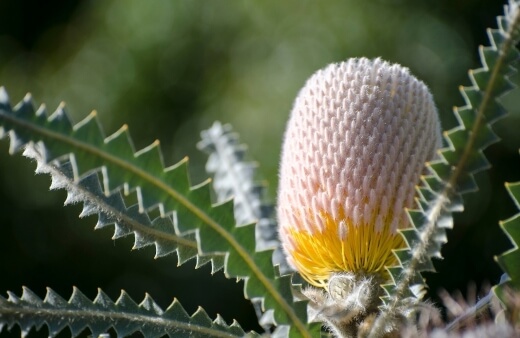
The most common means of propagating is through seed. Although the banksia seed can often take a little longer to germinate, the method is often successful. Plus, seeds are readily available from other banksia plants.
You will, however, have to prepare the seed cones in order to release the seed. Here’s what you’ll need to do:
- Place the seed cone into the oven at 120°C for about an hour.
- Allow the follicles to open, then remove the seeds using a pair of tweezers.
- Seeds should be sown freely onto the surface of a porous seeding mix.
- Once the first leaves appear, the seedling can be transplanted into a small pot.
Banksia Plant Care
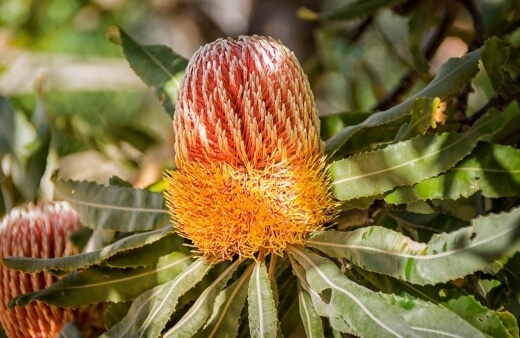
There really won’t be much banksia care required once the plant is established. Be sure to keep seedlings slightly moist as they start the growing stage; thereafter, you can cut back on watering every so often.
Take care not to over-fertilise your banksia. Once or twice every year is more than enough. Again, as these species do have nutrient-sensitive roots, over-fertilisation can lead to other issues.
While pruning may not always be necessary, it can be done to maintain shape and size or to remove any spent flowers once bloomed. Here, it is important to note that most Banksia has their peak flowering season during the winter.
As such, pruning should be carried out towards the end of winter. When pruning, take care not to cut back too much old growth. Rather focus your pruning efforts on the new growth.
Banksia Bush Tucker Guide

Australia is certainly blessed with one of the best nectar-producing plants in the world, the banksias. Also known as Honeysuckle, the flowers of the banksia plants are heavy producers of nectar which has made this plant a well-known bush tucker plant.
There are around 75 species of Banksia, where all but one species is native to Australia. Here is a short guide to using banksia as a bush tucker.
Traditional Applications
Traditionally, most of the Banksia varieties with orange and yellow flowers were used for their sweet, almost honey-like nectar. These flowers were sucked on for a quick sweet hit and quickly became highly regarded by the Aboriginal people.
Native diets were often bland so any sugar-yielding foods were highly sought-after and quickly popularised. The nectar was also commonly used in medicines to treat coughs, sore throats and even stomach issues.
Benefits of Using Banksia Flowers
Banksias have been a vital part of the food chain in the Australian bush for generations and they are also an important food source for much of our wildlife.
By planting banksia in your landscape, you are also supporting your local birds, bees and many insects that are an important part of our eco-systems.
Banksia flower nectar also contains some beneficial nutrients for us when consumed like vitamin C and other natural minerals.
How to Use Banksia Flowers
These days, the banksia flowers are still widely used as a bush tucker for their delectable nectar. The nectar has a very similar profile to honey so its uses are naturally similar as well.
You can collect and consume the nectar in a few ways. Most still simply suck the nectar straight through the flower spikes or soak the flowers in water to make a flavoursome cordial that can be used to make many refreshing drinks.
Sweet drinks made from banksia flowers are also sometimes mixed with wattle gum.
Collecting Banksia Flowers
It is recommended to pick and collect flowers filled with nectar in the mornings during the plants' active growing season in spring to early summer. Collecting flowers in the morning is advised as this will be before the sun has evaporated the nectar or it has been diminished by the birdlife in your area.
Popular Banksia Bush Tucker Varieties
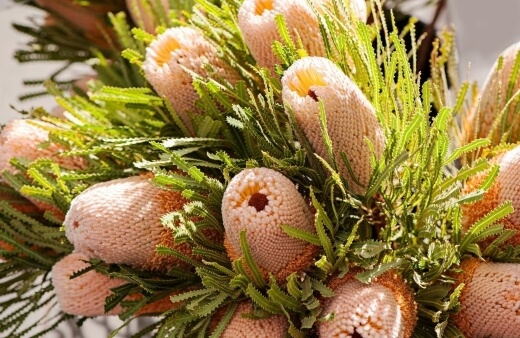
Orange and yellow flowering Banksia varieties with flowering spikes are commonly used for their sweet nectar as bush tuckers. Some of these popular varieties may include:
- Silver Banksia (B. marginata)
- Swamp Banksia (B. robur)
- Orange Banksia (B. prionotes)
- Woolly Orange Banksia (B. victoriae)
- Coast Banksia (B. integrifolia)
- Yellow Lantern Banksia (B. lemanniana)
Be sure to always first check with your local experts and research specific varieties to see if consuming the nectar from these plants is safe and won’t lead to any side effects for you.
Bush Tucker Summary
- Pick, collect and use nectar-filled flowers during spring in the mornings.
- Suck the nectar through the flower spikes as a fresh sweet snack.
- Soak the flowers in water to make a flavoursome cordial. Longer soaking periods will increase the intensity of the flavour. This drink can also be used to make jelly with added gelatin.
- Young flower spikes can be roasted and eaten or nectar can be consumed from them.
- Leaves can be steeped in water to make tea.
- With many varieties, the white bases of the leaves are edible and the flowers and seeds can also be eaten. Be sure to avoid consuming the spikes of the plant.
- Be sure to also strain your cordial after soaking to remove any stray material.
- Add ice to mixed drinks for a refreshing drink in the warmer months.
Banksia Common Pests, Problems and Diseases
Although a low maintenance plant, certain issues can arise that will need to be dealt with to protect your plant. These issues will depend on the location, environment and type of Banksia you have planted.
Some common issues include:
- Root Rot. One of the most common issues is root rot, which is caused by overwatering. Unfortunately, the signs of root rot make your banksia look like it may be too dry.
As a result, many gardeners then continue to overwater, essentially killing off their plants. Should you see wilting or browning leaves, cut back on watering almost completely.
Should the problem continue, you may need to consider re-planting. - Phosphorus Toxicity. As we’ve mentioned, banksia does not do well with high levels of phosphorus in the soil. Phosphorus toxicity will cause your leaves to be yellow and become damaged or warped.
Only fertilise once or twice per year, and be sure to check whether the fertiliser you are using is low in phosphorus.
Common Banksia Questions
How long does it take banksia to grow?
If you’re starting with a banksia seed, it can take anywhere between 2 to 3 years to begin flowering and around six years to reach its full height.
How long do banksia trees live?
Although they’ll take a few years to be established, once established, banksia trees can survive for over 100 years.
Will banksia grow in the shade?
While it is possible to grow in part-shade, the downfall would be a far lower production of blooms. Rather play it safe and plant your banksia in a beautifully sunny spot.
Can you grow banksia in pots?
Especially when soil conditions aren’t optimal, growing your banksia in a pot is a great option. Just be sure that your put has plenty of drainage holes and well-draining soil.
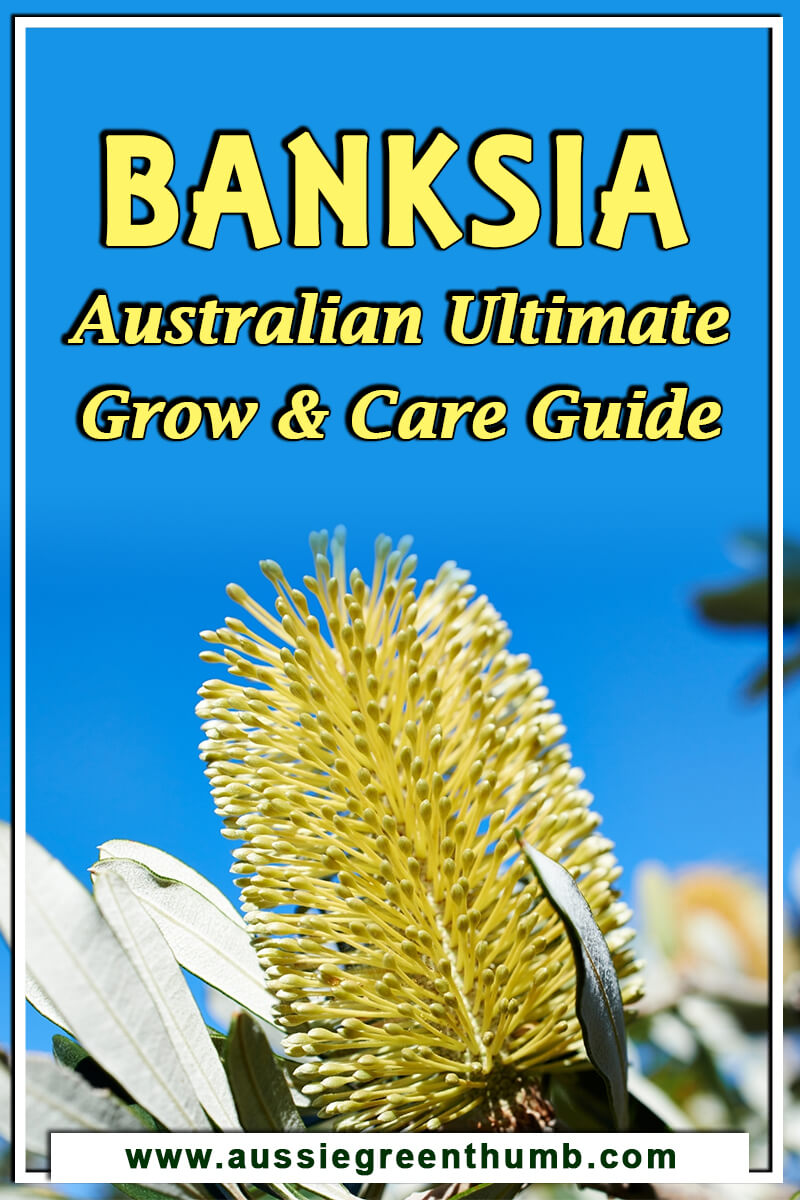
Celebrate Native Plants in Your Garden – Start Growing Banksia Today!
Growing banksia in your garden is not only a great way to add some colour and invite wildlife. It is a great way to homage to many beautiful Aussie natives we’re so blessed to have in Australia.
Whichever banksia variety you decide to grow, you’ll be able to enjoy a wonderous, flowering spectacle throughout most of the year. Give your garden that glow it deserves – start growing Banksia in your garden today!
Published on May 2, 2022 by Nathan Schwartz
Last Updated on February 21, 2025





I am growing Banksia Robur (Swamp Banksia in a large pot). He is growing well, but something is eating his leaves. Do you have any suggestions as to how I can stop all his leaves being eaten? I don't know what is eating his leaves, but whatever it is, it's eating away at him. I tried spraying him with Richgro's Beat-a-Bug insect spray, but it burnt his leaves and what didn't get burnt were eaten. We live in Newcastle.
Hi Kate,
Sorry to hear you’re having pest problems with your Banksia, they’re usually very resilient. The only common Banksia specific pest is the Banksia boring moth, but it’s unusual anywhere north of Victoria.
Having said that, there are still plenty of caterpillar species that will thrive on happy Banksias and most will only be killed by direct contact with Pyrethrins (the active chemical in Beat-a-bug). The deterrent ingredients are more effective on other pests.
The only 100% effective way to get rid of caterpillars is to pick them off one by one. If you’ve got a bird table, they’ll make light work of them, and once they know they’re there will usually keep your garden caterpillar free naturally.
If the pesticides have damaged the leaves more widely, I’d steer clear of anything other than deterrent sprays in future, and consider planting nasturtiums or even ornamental kales nearby. The caterpillars will go for them instead, and they grow so prolifically that you’ll barely notice the damage… Plus, they attract wasps that will eat the caterpillars.
Fingers crossed that helps, but do let us know. Caterpillars are the likely cause, but it’s quite unusual where you are.
Best regards,
Gary Clarke
My very established Banksia (NSW Central Coast) is looking unwell. It appears to be 'bleeding' from two of its trunks – and has a green tinge on the trunk where it is weeping.
Have you any suggestions as to what may help – I suspect it may be a case of root rot – but really not sure. Because of this I have refrained from over-watering.
Any assistance would be greatly appreciated. Thank you.
Hi,
Have you got any photos?
It sounds more like the result of borers than root rot. Root rot would cause a more overall decline, and dry, yellow leaves etc. It would be unusual for root rot to cause issues with the trunk before any foliage decline was spotted.
As for the green, if it’s leaking (particularly through excess sap production if there’s any pest damage) that could just be algae, or bacterial action of the damp wood.
If you’ve got any pictures of the damaged section that would be really helpful. And if not, maybe just try spraying the damaged site with a neem oil fungicide to get rid of any potential pests. It won’t do the tree any harm, and might help regardless.
Best regards,
Nathan